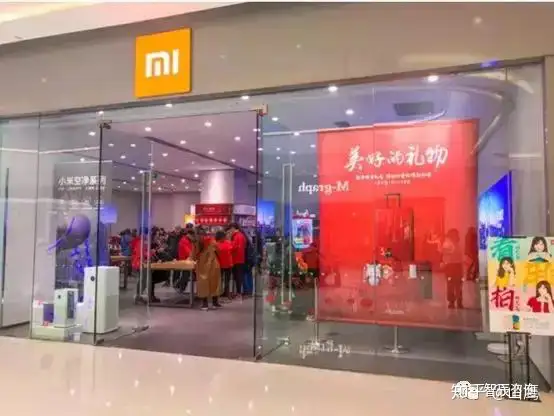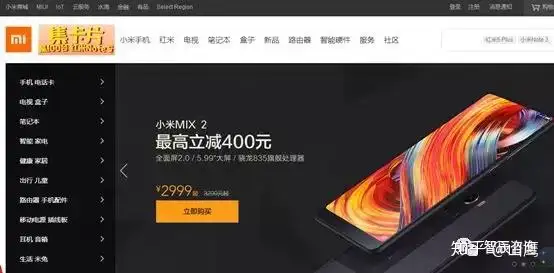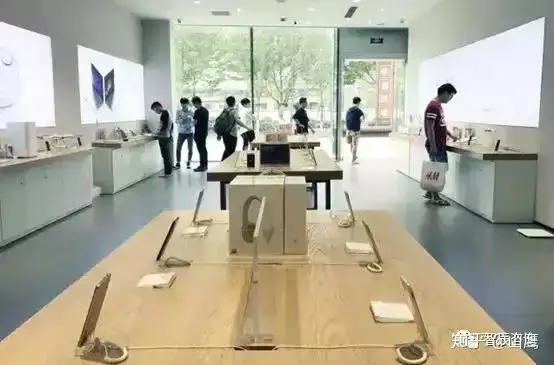
最近雷布斯很火,科技圈热传他的小米正在运作IPO上市,目前小米当前资产估值为540亿美元,上市后保守估计市值为1000亿美元,另有一种说法是,雷军给小米定调2000亿美元的目标,并且受到了投行的认可。这也意味着,小米将成为2014年阿里巴巴赴美上市以来,上市规模最大的科技类公司。传言小米上市之后,雷军将成为中国首富。
小米成立于2010年,经过短短9年的发展,创造了众多奇迹,业内也一直谈论“小米现象“,雷军提出的“风口理论”、“飞猪理论”,也成为很多公司学习和借鉴的新理论。小米在2016年经历一番挫败,雷军开始重新审视和思考之前的战略,经过2017年的触底反弹,强势回归,小米和雷军被再次封神,也获得资本的热捧,上市之路,一片光明,企业估值也水涨船高。
2017年,雷军对小米做了哪些战略调整,让小米重新进入手机第一阵营?笔者认为,小米的O2O战略升级,是让小米回归的重大因素。笔者现从自己的经验和对小米公司及小米模式的了解,尝试剖析小米的转型升级之路,以飨读者。
经过2016年的小米之败,雷军反思,过去犯得最大错误之一,就是忽视了线下。因此在2017年,雷军开始大力布局线下实体店,建小米之家旗舰店,产品线上线下同价,利用数字化技术,打通线上线下的购物体验,进行营销和运营,大力布局和推进新零售。
小米的新零售,是让线下的小米之家和线上的小米商城,实现同款同价。雷军在2017年天下网商大会上说,小米要做科技界的无印良品,用互联网的技术和方法做线下零售,保持高品质、高性价比,打造小米模式。
小米之家总经理张剑慧在2017年工作报告中表示,小米之家在2017年共覆盖170个城市,新增235家门店,2家品牌店(深圳旗舰店、上海东方明珠店),共接待了6713万人次。而进入2018年初,小米之家已经突破300家。
据雷军表示,小米之家的(年)坪效已经做到了27万元/平米,仅次于苹果专卖店的40万/平米,远高于其他手机专卖店的坪效。
从2017年的小米的手机出货量和营收来看,小米的O2O转型战略是成功的。
那么,小米的O2O战略转型是如何实现的,从而带来整体业绩的逆袭的?

一、小米O2O新零售战略布局
小米的新零售营销战略采用“社交媒体+电子商务+社区旗舰店”的O2O营销方式以及高性价比的爆款产品战略。

二、O2O战略详细分析
1. 社交媒体营销聚客:
通过QQ群、QQ空间、论坛、微博营销等线上营销手段,小米聚集了几千万的粉丝,并打出“为发烧而生“的口号,发烧友通过各种线上渠道将产品的使用体验和改进建议,反馈到小米的工作人员,工作人员从用户反馈中获取产品的各种意见和需求,再反馈到后台研发部门,对产品进行功能升级。用户的反馈有多重要,从两个点就可以管中窥豹,比如小米手机的短信功能优化建议,小米手机从用户为短信接受发送功能提出的改进建议方面,共确认了28个需要改进的功能点,注意,是已经确定需要进行开发排期,对功能进行升级改造的需求点,而非用户反馈的问题点,注意两者之间的差别;在电话接听功能方面,用户提出需要在特定的时间段可以允许特定的电话call进来,未被允许的电话将打不进来,满足不同商务需求需要,这个功能也被小米所采纳;
2. 电子商务平台获客和转化:
在当前的数字化时代,电商平台应该是企业营销的标配了,就算企业没有自建电商平台,也要进驻几个大的电商平台做产品宣传和销售。小米通过自建电商平台,将线上其他平台的用户引流到自建电商平台,进行销售转化。
在电商平台上,还有小米社区板块,米粉可以在社区论坛中,跟小米工作人员进行交流,提出改进建议,进行线下米粉聚会交流,这些方式,加深了用户与小米的互动和粘性,同时也提高产品在米粉中的口碑宣传。

3. 社区旗舰店选址:
小米之家的选址逻辑对标优衣库、星巴克、无印良品等快时尚品牌,并且形成了小米特有的旗舰店选址模型,一般在选址时从客流量、地理位置、显眼程度、客流人群消费能力等因素进行考虑和分析,对店址潜力进行评估。当前小米之家,主要选在一二线城市核心商圈的购物中心,优先和知名地产商合作,比如万达、华润和中粮,另外也会进驻一些购物中心。
对于线下店来说,选址是非常重要的一环,地址选不好,将会在天然上对营销、获客、销售带来很大的问题,即便后期加大营销投入,也可能无法扭转劣势。因此选址很重要,不要用后天的资源去填先天的坑,有时候坑大的是填不满的。


4. 爆品策略:
重视产品质量,提高产品性价比是小米的主要产品竞争战略。用望远镜看创新,用显微镜看品质。通过高性价比,打造爆款产品,用爆款产品带动其他产品销售。
在技术创新层面,小米不断技术创新,通过自主研发澎湃S1处理器芯片并量产商用,成为全球仅有的四家同时具备手机芯片和手机整机自主设计、制造能力的企业之一;采用全面屏技术,引领全球业界集体跟进“全面屏”,中国消费电子行业第一次掌握全球技术演进方向的主导权。
在产品品类方面,小米布局的产品生态链优势凸显,小米插排,小米电池,小米充电宝,小米AI音响,小米扫地机器人,小米空气净化器等等各种小米系列产品,小米之家店内现在有20-30类品类、200-300件产品,所有品类一年换一次,相当于每隔半个月顾客都会进店购物。通过手机的销售拉动,带动周边其他产品的销售,实现小米产业价值链的连通,为粉丝提供了多品类的产品选择。
在品牌竞争方面,小米产品通过较高的性价比,在消费者,尤其是粉丝中,具有较高的产品口碑。小米产品在小米note3、OPPO R11s、vivo X20均采用高通骁龙660芯片,像素分别为1600万、2000万、2400万,同样4GB+64GB配置的手机售价分别为1899、2799、2798。小米手机性价比优势明显。小米手机1000元以下价位段对OV(OPPO和vivo)等竞品影响更大,尤其是红米系列,销量巨大。
在产品促销方面,小米手机本来性价比就比较高,价格中等偏下,然后又定期进行降价促销,吸引顾客,在销售转化方面优势明显,并带动其他产品的销售;


三、小结:线上线下融合打通,提高粉丝的购买体验
小米之家,通过线下的自然流量加上线上导流到小米之家旗舰店的客流,确保了每天的进店流量;
线上线下产品同价,将线上的产品嫁接到三百平米的旗舰空间,实现了有限空间的最大化品类展示,小米全系产品都可在有限的小米之家进行销售和配送,提高了消费者的品类选择空间。
线上线下的打通,也在无形之中,提高了小米之家的人群覆盖人数,由原来的商超客流量提升到方圆几公里的线上线下用户群。
通过以上营销策略的推进,小米打通了线上线下的购物体验,在有限的坪效范围之内,提高了产品的购买率和用户到店频次,真正实现了突破线下零售实体店的空间局限,提高了实体店的营收。客流量增加,消费金额和频次增加,客单价增加,所以就造就了小米之家年27万元/平的坪效。
从小米的战略转型来看,线上线下的融合,购物体验的打通,是提升企业销量的有效途径,产品同价,营销同步,库存共享,支付便捷,借助信息化手段和数字营销技术,在产品品类、产品价格、用户体验、场景营销的方面,可以有效对用户进行识别和营销,从而提升线上电商平台和线下实体店的销售转化,线上线下的融合,也拓高实体店的经营天花板,实现了线上线下的双赢。
雷军说“用户的信任”是小米商业模式的核心。用户进了小米之家或者登录小米商城,可以“闭着眼睛买”,因为可以放心:品质、价格一定都是最优的。这也许就是小米O2O给用户带来的最佳的购物体验,对其他企业数字化转型也是一个很好的借鉴。
翻译:
Recently, Rebus is very popular, the tech circle is hot rumors that his Xiaomi is working on an IPO, the current assets of Xiaomi is valued at $54 billion, the market value after the IPO is conservatively estimated to be $100 billion, another theory is that Lei Jun has set a target of $200 billion for Xiaomi, and has been approved by investment banks. It would also make Xiaomi the biggest technology company to go public in the US since Alibaba in 2014. Lei Jun is rumored to be the richest man in China after Xiaomi goes public.
Founded in 2010, Xiaomi has created many miracles after just 9 years of development. The industry has been talking about the “Xiaomi phenomenon”. The “Tuyere theory” and “flying pig theory” proposed by Lei Jun have also become new theories for many companies to learn from. Xiaomi experienced a setback in 2016, Lei Jun began to re-examine and think before the strategy, after the bottom rebound in 2017, strong return, Xiaomi and Lei Jun were again gods, also get the capital of the hot hold, the road to listing, a bright, enterprise valuation is also rising.
What strategic changes did Lei Jun make to Xiaomi in 2017, allowing Xiaomi to re-enter the first mobile phone camp? The author believes that the upgrading of Xiaomi’s O2O strategy is the major factor that makes Xiaomi return. The author is now from their own experience and understanding of Xiaomi company and Xiaomi model, try to analyze the transformation and upgrading of Xiaomi road, to satisfy readers.
After Xiaomi’s failure in 2016, Lei Jun reflected that one of the biggest mistakes he made in the past was to ignore offline.
Therefore, in 2017, Lei Jun began to vigorously layout offline physical stores, set up the flagship store of Mi Home, the same price of products online and offline, the use of digital technology, through online and offline shopping experience, marketing and operation, vigorously layout and promote new retail.
Xiaomi’s new retail is to make offline Mi Home and online Mi mall realize the same model at the same price. Lei Jun said at the 2017 World Internet Business Conference that Xiaomi wants to be the Muji of science and technology, use Internet technology and methods to do offline retail, maintain high quality, cost-effective, and create a Xiaomi model.
Zhang Jianhui, general manager of Mi Home, said in the 2017 work report that Mi Home covered a total of 170 cities in 2017, adding 235 stores, two brand stores (Shenzhen Qijian Store and Shanghai Oriental Pearl Store), and received 67.13 million visits. At the beginning of 2018, Mi Home has exceeded 300.
According to Lei, Mi Home has achieved 270,000 yuan per square meter, second only to Apple Store’s 400,000 yuan per square meter, and much higher than other mobile phone stores.
Judging from Xiaomi’s mobile phone shipments and revenue in 2017, Xiaomi’s O2O transformation strategy is successful.
Then, how is Xiaomi’s O2O strategy transformation realized, so as to bring the overall performance of the counterattack?
1. Xiaomi’s O2O new retail strategic layout
Xiaomi’s new retail marketing strategy adopts the O2O marketing method of “social media + e-commerce + community flagship store” as well as the cost-effective popular products strategy.
2. Detailed analysis of O2O strategy
(1) Social media marketing gather customers:
Through QQ groups, QQ Spaces, forums, micro-blog marketing and other online marketing means, Xiaomi has gathered tens of millions of fans, and issued the slogan “Born for fever”. Through various online channels, the enthusiasts will feed back the product experience and improvement suggestions to the staff of Xiaomi, who will obtain various opinions and needs of the product from the feedback of users. Then feedback to the background research and development department, to upgrade the product function.
How important the user’s feedback is, we can get a glimpse from two points, such as the millet mobile phone SMS function optimization suggestions, Millet mobile phone from the user for SMS acceptance and sending function improvement suggestions, a total of 28 function points need to be improved, attention, has been determined to carry out development schedule, the need for functional upgrading points, Not the problem with user feedback, notice the difference between the two; In terms of the phone answering function, users have proposed that specific calls can be allowed in a specific period of time, and calls that are not allowed will not be made to meet different business needs. This function has also been adopted by Xiaomi.
(2) Customer acquisition and transformation of e-commerce platform:
In the current digital era, e-commerce platform should be the standard part of enterprise marketing. Even if enterprises do not build their own e-commerce platform, they should also enter several large e-commerce platforms for product promotion and sales. Through its self-established e-commerce platform, Xiaomi transfers users from other online platforms to its self-established e-commerce platform for sales transformation.
On the e-commerce platform, there is also the Millet community plate. Mi fans can communicate with Xiaomi staff in the community forum, put forward suggestions for improvement, and hold offline Mi fans’ gathering and communication. These methods deepen the interaction and stickiness between users and MI, and also improve the word-of-mouth publicity of products among Mi fans.
(3) Location of community flagship store:
The location logic of Mi Home is based on fast fashion brands such as Uniqlo, Starbucks and Muji. And forms a unique location model of Xiaomi’s flagship store. In general, factors such as customer flow, geographical location, visibility and consumption power of customer flow are considered and analyzed during location selection to evaluate the potential of the store location. Currently, Mi Home is mainly located in shopping malls in the core business areas of first – and second-tier cities, preferentially cooperating with well-known real estate developers such as Wanda. China Resources and Cofco, and will also be located in some shopping malls.
For offline stores, site selection is a very important link. Poor address selection will naturally bring great problems to marketing, customer acquisition and sales. Even if marketing investment is increased in the later stage, it may not be able to reverse the disadvantage. Therefore, location is very important, do not use acquired resources to fill the congenital pit, sometimes the pit is too big to fill.
(4) Explosive Strategy:
Attaching importance to product quality and improving product cost performance is the main product competition strategy of Xiaomi. Look at innovation through a telescope, quality through a microscope. Through high cost performance, to create popular products, with popular products to promote the sales of other products.
In terms of technological innovation
In terms of technological innovation, Xiaomi keeps innovating. Through independent research and development of ThepaperS1 processor chip and mass production and commercial use. Xiaomi has become one of the only four enterprises in the world with independent design and manufacturing capabilities of mobile phone chip and mobile phone complete machine. The adoption of comprehensive screen technology, leading the global industry to collectively follow up “comprehensive screen”. China’s consumer electronics industry for the first time to grasp the global technology evolution direction of the dominant.
In terms of product categories
In terms of product categories, the advantage of the product ecological chain of Xiaomi layout highlights, Xiaomi plug, Xiaomi battery, Xiaomi charging bank, Xiaomi AI audio, Xiaomi sweeping robot, Xiaomi air purifier and so on a variety of Xiaomi series products, Xiaomi home store now has 20-30 categories, 200-300 pieces of products, all categories change once a year, It is equivalent to customers coming into the store every two weeks. Through the sales of mobile phones, the sales of other surrounding products are driven to realize the connectivity of Xiaomi’s industrial value chain and provide fans with a variety of product choices.
In terms of brand competition
In terms of brand competition, Xiaomi products enjoy a high reputation among consumers. Especially fans, due to their high cost performance. Xiaomi’s Mi note3, OPPO R11s and vivo X20 all use Qualcomm Snapdragon 660 chips with 16 million pixels, 20 million pixels and 24 million pixels respectively. The same 4GB+64GB configuration phones are priced at 1899, 2799 and 2798 respectively. Xiaomi has obvious advantages in cost performance. Xiaomi mobile phone price range below 1000 yuan has a greater impact on rival products such as OV (OPPO and vivo). Especially the red rice series, which has a huge sales volume.\
In terms of product promotion
In terms of product promotion, Xiaomi mobile phone has a relatively high cost performance, the price is lower than the average. And then regular price promotion, to attract customers, obvious advantages in sales transformation, and drive the sales of other products;
3. Summary: Integrate online and offline to improve fans’ purchasing experience
Xiaomi Home ensures daily in-store flow through the natural offline flow and the online flow that directs to the flagship store of Xiaomi Home.
Online and offline products at the same price, grafting online products into 300 square meters of flagship space, to achieve the maximum category display of limited space, Xiaomi’s entire series of products can be sold and distributed in the limited Mi home, improve the category choice space for consumers.
The connection between online and offline has also improved the number of people covered by Mi Home from the original shopping mall passenger flow to online and offline user groups within several kilometers.
Through the promotion of the above marketing strategies, Xiaomi has opened up the online and offline shopping experience.
Through the promotion of the above marketing strategies, Xiaomi has opened up the online and offline shopping experience, improved the purchase rate of products and the frequency of users’ visits to stores within the limited space efficiency range, truly achieved a breakthrough in the space limitation of offline retail physical stores, and increased the revenue of physical stores. With the increase of passenger flow, consumption amount and frequency. And customer unit price, Millet Home has an annual efficiency of 270,000 yuan per square meter.
From the perspective of Xiaomi’s strategic transformation, the integration of online and offline and the opening up of shopping experience are effective ways to increase the sales volume of the enterprise. With the same product price, marketing synchronization, inventory sharing and convenient payment. Users can be identified and marketed effectively in terms of product categories, product prices. User experience and scene marketing with the help of information means and digital marketing technology. Thus, the sales transformation between online e-commerce platform and offline physical stores can be improved. And the integration of online and offline stores can also expand the management ceiling of physical stores, achieving a win-win situation between online and offline.
Lei said “users’ trust” was at the heart of Xiaomi’s business model. When users enter Mi Home or log in Mi Mall, they can “buy with their eyes closed”. Because they can rest assured that the quality and price must be the best. This may be the best shopping experience Xiaomi O2O brings to users. And it is also a good reference for other enterprises’ digital transformation.
免责声明:本网站安心库Anshinko (https://anshinko.com)内容主要来自原创、合作媒体供稿和第三方投稿,本文为本网站出于传播商业信息之目的进行转载发布,不代表本网站的观点及立场。本文所涉文、图、音视频、LOGO、软件、程序等资料之一切权利和法律责任归原作者所有和承担。本网站对此资讯文字、图片等所有信息的真实性不作任何保证或承诺,亦不构成任何购买、投资等建议,据此操作者风险自担。
任何单位或个人认为本网站中的内容可能涉嫌侵犯其知识产权或存在不实内容时,请及时通知本站,予以删除。








 浙公网安备 33010602013084号
浙公网安备 33010602013084号